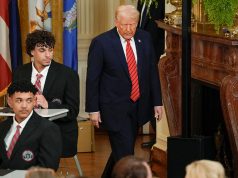HANOI — Ministers from Asia-Pacific countries discussed the changing global trade landscape on Saturday after US President Donald Trump upended the old order with an “America First” policy that has sparked fears of protectionism.
It is the biggest trade meeting since Trump took office and brings together ministers from the United States, China, Japan and other Asia-Pacific Economic Cooperation countries that account for more than 40 percent of world trade.
At the opening in communist Vietnam’s capital, Hanoi, Prime Minister Nguyen Xuan Phuc highlighted three decades of growth in APEC and said: “That’s the proof of our group’s effort on liberalization.”
A draft seen by Reuters of the meeting statement to be issued on Sunday also emphasized free trade.
“In some of our communities there are increasing numbers of people questioning the benefits of globalization and free trade, spurring protectionist trends,” it said.
“Against that backdrop, we reaffirm our commitment to promote trade and investment liberalization.”
But the differing visions are evident in the discussions on the sidelines.
New US Trade Representative Robert Lighthizer will have individual meetings with counterparts from some of Washington’s most important trading partners — in line with proposed bilateral deals that Trump argues can best protect American jobs.
Proposed Asia partnership
China, putting itself forward as a global free trade champion in light of the US shift, will be pushing a free trade agreement to encompass the vast majority of Asian economies. The Asia trade deal it favors is called the Regional Comprehensive Economic Partnership.
Officials said there remained significant points of disagreement in the talks on RCEP between Southeast Asian countries, China, India, Australia, New Zealand, Japan and South Korea. The United States has never been part of those discussions.
Japan is leading countries that want to persist with the Trans-Pacific Partnership trade deal ditched by Trump in one of his first acts in office. TPP excludes China and covers a broader scope than the trade agreement favored by Beijing.
Malaysian Trade Minister Mustapa Mohamed told Reuters there was optimism the United States would return to TPP one day, because Trump had shown readiness to shift his position on other matters, such as softening his stance towards China.
“There has been less rhetoric and a more realistic approach,” he said.
However, renegotiating the existing North America Free Trade Agreement is a bigger immediate priority for Washington.
Canada and Mexico are at the Asia-Pacific meetings and are also in the North American trade area.










